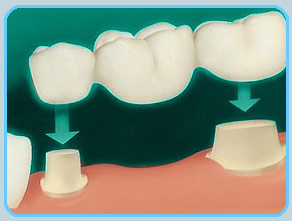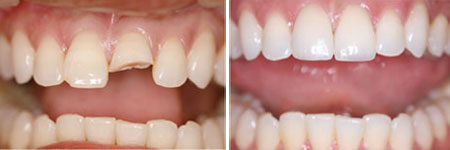
Dental Bridges at Torgersen Dental, Camarillo & Simi Valley

Dental bridges literally bridge the gap created by one or more missing teeth.
A bridge consists of two crowns for the teeth on each side of the gap - these two anchoring teeth are known as "abutment" teeth – and a false tooth or teeth between them. These false teeth are called Pontics and can be made from gold, alloys, porcelain or a combination of both. Dental bridges are supported by natural teeth or dental implants.
Benefits of Dental Bridges
Bridges are beneficial for the following reasons:
- Restore your smile
- Improve your ability to chew and speak properly
- Preserve the shape of your face
- Distribute the forces of your bite evenly by replacing the missing teeth
- Prevent the remaining teeth from moving out of their position.
Types of Available Dental Bridges
Three main types of dental bridges:
- Traditional bridges entail the creation of a crown for the tooth or implant on either side of the missing tooth, with a pontic between them. Traditional bridges are either made of porcelain fused to metal or ceramics.
- Cantilever bridges are used when there are adjoining teeth on only one side of the missing tooth or teeth.
- Maryland bonded bridges (also known as resin-bonded bridge or a Maryland bridge). They are made of plastic teeth and gums supported by a metal frame. Metal wings on each side of the bridge are bonded to your remaining teeth.
Process for Getting a Dental Bridge
During the first visit for a dental bridge, the abutment teeth are prepared. Preparation involves reshaping these teeth by removing a portion of enamel to make room for a crown be placed on top of them. Then, impressions of your teeth are created, which serve as a model from which the bridge will be constructed by a dental laboratory. Dr. Trent and Gina Torgersen will make a temporary bridge to cover the exposed teeth and gums while your bridge is being made.
During the second visit, the temporary bridge will be removed and the new permanent bridge will be examined and adjusted, as required, to obtain an appropriate fit. A few visits may be needed to check the fit of the metal structure and bite. This will depend on the case of each patient. If the dental bridge is a fixed (permanent) bridge, Dr. Trent and Gina Torgersen may temporarily cement it in place for a couple of weeks to make sure it fits accurately. After a few weeks, the bridge is cemented in place permanently.
Dental bridges can last from 5 to 15 years and even longer. It is not unusual for the life span of a fixed bridge to be over 10 years if you follow proper oral hygiene and regular checkups.
Restoration of the missing teeth with a dental bridge should certainly make the eating easier. Until you get used to the bridge, eating of soft foods that have been cut into small pieces is recommended.
When teeth are missing in the front or anterior areas, it can be very bothersome to speak clearly. Wearing a dental bridge with the front teeth in their conventional proportion allows you to speak properly.
It is essential to keep your existing teeth strong and healthy as the success of the bridge (relying on the selected type) depends on the solid foundation sustained by the adjacent teeth. Tooth decay and gum disease that can lead to tooth loss can be prevented by brushing twice a day and flossing every day. Dr. Trent and Gina Torgersen or dental hygienists can walk you through the proper way of brushing and flossing. Maintaining a regular cleaning schedule will help determine problems at an early stage when treatment has a better speculation. It is also important to choose a balanced diet for proper nutrition.

Before and After Bridges Treatment 1

Before and After Bridges Treatment 2
Call for your appointment today!


